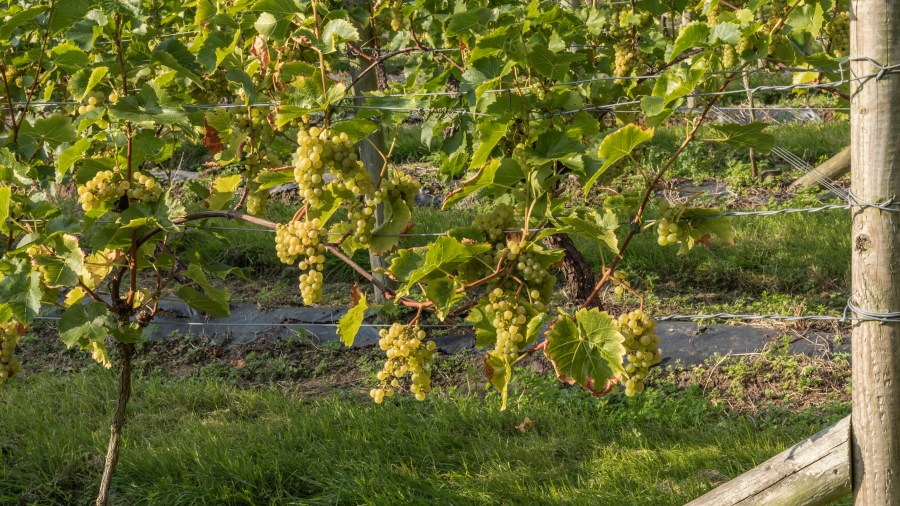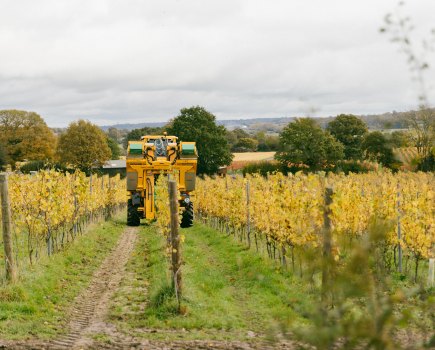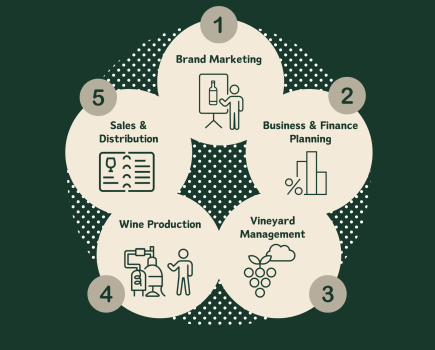Ask your average shopper to name the variety of wheat that’s gone into their daily loaf, and its my guess that unless you happened to have approached an arable farmer, the likely answer is ‘dunnow’. Ask the same person the same question, but substitute ‘beer’ for ‘wheat’ and my guess is that the answer would be similar. However, hover in the wine aisle of any supermarket and approach anyone scanning the shelves for a bottle to take home and ask them what their favourite grape variety is, and its more than odds on that they will not only have one favourite grape variety, but will almost certainly be able to name a few red cultivars and a few white ones. They might also know that some varieties come from one region and others from another, and that Cabernet Sauvignon (for instance) goes well with their Sunday roast and that Chardonnay makes both great still white wines as well as Champagnes (and other sparkling wines).
In short, the average wine drinker in many instances uses the grape variety to navigate their way through the myriad of wines found in even the most modest of shops selling the stuff. Growing the right variety then, is not only important in determining the style and quality of a wine, but also an important part of marketing a wine.
Of course, it wasn’t always thus. Until the early 1950s, just before the time that those new-fangled shops called ‘supermarkets’ became popular, the average consumer bought their wine (if they bought it at all) from the grocer that sold them their weekly shopping. In those days, most of the popular wines were sold under generic names, Claret, Burgundy, Hock, Moselle, or brand names – the ‘Toujour’ range of red and white French wines in litre bottles were a top-selling line – and rarely, if ever, by grape variety. Wines from the major wine regions, Bordeaux, Burgundy, Rioja, Chianti, would never have had the grape varieties on their labels (and often still don’t) and only the very knowledgeable would have wanted to know or even cared.
How things have changed. For most wine drinkers, the variety is a shorthand way of getting to the wine they want. Price, colour, variety – these are the three most important pointers in the ‘what wine are we having tonight’ hunt, with maybe country or region of origin thrown in to the mix. And it’s much the same in hotels and restaurants. Ask a waiter ‘what wine have you got by the glass? and they will usually reel of a list of varieties available as their opening offer. And I firmly believe that this reliance on vine variety as a basic descriptor is one of the main reasons why our wines – still and sparkling – have become more acceptable since the major varieties we grow have changed. ‘It’s made from Müller-Thurgau and Reichensteiner with a touch of Huxelrebe,’ does not sound nearly as inviting as ‘it is a Chardonnay and its quite like a Chablis’; this is even more important for sparkling wine. ‘Its just like Champagne and made from Chardonnay and Pinot noir’ is so more appealing than saying ‘it’s made from Kerner and Seyval blanc, with a touch of Siegerrebe’. Choice of variety is therefore important in many ways other than just how it grows and performs.
When selecting a variety or varieties for your vineyard, some basic rules apply. Like all regions, there is a list of ‘top’ varieties, often dictated by appellation regulations or by historic reasons, but always hemmed in by climatic factors. That’s why GB doesn’t grow any Grenache or Semillon, both varieties suited to 35°C+ days. Some varieties of course are more adaptable than others. Chardonnay, our major variety, can be found in almost every winegrowing region, but the style of wine changes. Sparkling and high-acid still wines in cooler regions; oaked whites in warmer regions.
GB’s variety lists started to change after 2003, the year when people said it was too hot in Champagne to make decent wine! In that year, Chardonnay overtook Müller-Thurgau as the most widely grown variety, and it hasn’t stopped. Today, it occupies very nearly one-third of all plantings. The top 5 in Britain – Chardonnay, Pinot noir, Meunier, Bacchus and Seyval blanc – account for 80% of all the vines grown, with newcomer Solaris sitting right behind Seyval and probably about to overtake it as the farther flung regions get bevined. But – do these statistics help when choosing a variety? Well I believe they do. If nothing else, they show that 1,000 plus growers have faith in what we can now surely call ‘established’ varieties. The biggest growers, with perhaps one or two exceptions, are firmly wedded to producing mainly (or even only) Champagne-style sparkling wines, and for them there’s little choice but to grow the three major sparkling wine cepages. Bacchus (and thank heavens the Germans gave it a name that has become a brand in its own right) has enough critical mass to stay around as a Sauvignon blanc look-a-like, and those interested in buying English and Welsh wines from Bacchus have a wide selection of styles to choose from. After these four, the lists start to fragment. I firmly believe that Seyval has a place in GB vineyards (and I know this is a minority view) but with the pressure to increase yields (to reduce per tonne growing costs) and to reduce the use of pesticides (aka ‘regenerative agriculture’), this variety is uniquely positioned. There is a 75 year history of growing it here, the wines adapt well to sparkling and blending, and it is the only variety (currently) that is highly resistant to both powdery and downy mildew.
As I have said above, as viticulture heads for the cooler, wetter and windier hills and valleys of the far south-west, Wales, and counties north of the Wirral to the Wash line, the demand for higher yielding, diseases resistant varieties will grow.
After these first five varieties, the list starts to descend towards very small numbers. As has been mentioned, Solaris is increasing, mainly because it (a) yields well and (b) is relatively disease resistant, although I really worry (as you will read later) about wine quality. The up and coming varieties are a mixture of varieties grown in other cool climate regions, Pinot gris and Pinot blanc, both able to make good to very good still wines (and sparkling) on the right sites; Ortega, a bit of a GB speciality that again, can make great still wines; and Blauer Frühburgunder (Pinot noir Précoce), grown by many Pinot noir growers to boost the sugars and colour in their red and rosé wines.
After that, the field is wide open, with a mixture of old German crosses and newer interspecific crosses and PIWIs. Out of the 84 varieties listed as being grown in GB in 2023, there are 27 modern hybrids (PIWIs) which together occupy 293ha, and seven older hybrids which occupy 119ha (of which Seyval is 112ha). With the exception of Seyval, I doubt there are any new plantings of the older hybrids.
PIWI varieties
PIWIs have been around a lot longer than most people realise. In 1982, three growers – myself, Lamberhurst, and Adgestone, were each given 50 Rondo vines (or GM 6494/5 as it was known for its first ten years in GB) by Professor Helmut Becker who at the time was head of the Geisenheim vine breeding department and for whom Rondo was the first commercial release of his vitis Amurensis crossings. Early and disease resistant, with a generous yield of deep red grapes, it was an instant hit, and once the first 50 vines had been cropping for a few years, some of Lamberhurst’s contract growers planted it. Rondo, together with three other PIWIs, Orion, Phoenix and Regent, were put on the ‘authorised’ list and people started planting them. Today there are 133ha of these four varieties in GB and with the exception of Orion, are (very) slowly expanding. The major problem with these four varieties is that the wine quality is not of the first order, winning very few silver and gold medals over the past 50 years. But Rondo is a consistent cropper even in cooler years (and cooler regions).
This question of wine quality is, to my way of thinking, central to the whole PIWI debate. As we saw in the past, when new varieties were promoted by overseas nurseries and authorities (Geisenheim included), almost no trials had been undertaken in GB, and therefore all the received wisdom about a variety’s attributes, whether cultural or about wine quality, is derived from regions which almost always have better growing conditions than ours and therefore their wine quality is naturally better, and nothing much has changed in this respect. Take Divico as an example. This Swiss variety was chosen by the NIAB East Malling Research Station by the person then in charge of the viticulture section, who was looking for a variety to produce top-quality red wine. Alighting on Divico he said: “The wine quality is outstanding… and Divico is likely to supersede Pinot Noir… the previous industry standard red variety”. Much on the basis of this glowing report, a total of 12ha of this variety has been planted. Whilst I wish all the best to everyone that swallowed the Kool Aid, and I look forward to tasting the first Divico gold medal and trophy winner, my natural inclination, and my experience of growing new ‘wonder’ varieties, indicate to me that it will be a long while before it eclipses Pinot noir as GB’s main red wine variety. The second most widely planted ‘new PIWI’ is Cabaret Noir, again with 12ha. I suspect much of the popularity with this variety is its name, which launched as Cabernet Noir, until the EU decided that this was misleading and made the breeder rename it. Unlike Divico, I have actually tried a few good wines from this variety, and I wish it every success for the future. Of the other newer PIWIs, only a few have been planted at the ‘more than 1ha’ level: Sauvignac, Muscaris, Cabernet Cortis, Souvignier Gris, Pinotin, Johanniter, and Cabernet Blanc. Together, these seven varieties occupy just under 24ha. There are a few plantings of Voltis, the PIWI variety, which is allowed to be grown in Champagne, and maybe because of this, it will become more widely planted in GB.
As I said above, wine quality is the problem, especially when these newer and untried varieties are grown outside the heartland of GB winegrowing where climatic conditions are worse for viticulture and therefore for wine quality. What happened to new varieties planted in the 1990s such as Findling, Kernling, Optima, Scheurebe and Zweigeltrebe? The 18ha then planted have all but disappeared, mainly because their wine quality was lacking. What we really need is the modern-day equivalent of the Wye College vineyard, first planted in 1971, which trialled around 25 varieties new to GB, and which gave us Bacchus, our major still wine variety. Maybe a job for Plumpton?
For more like this, sign up for the FREE Vineyard newsletter here and receive all the latest viticulture news, reviews and insight




